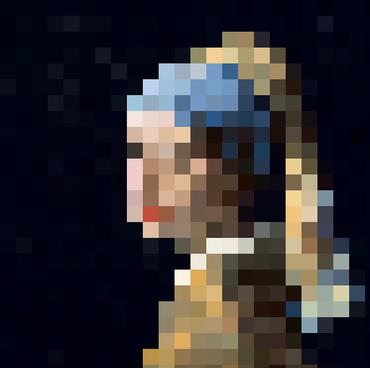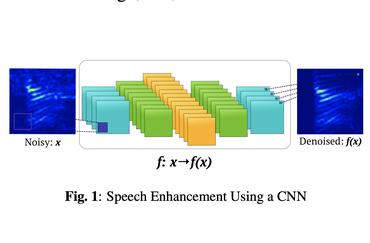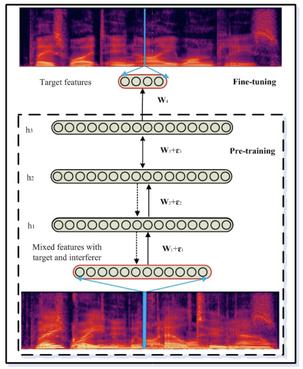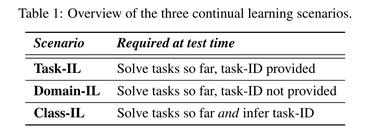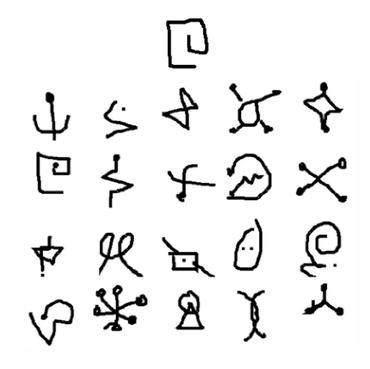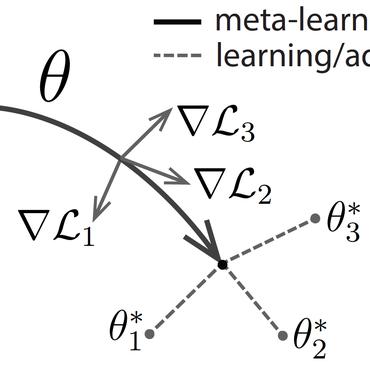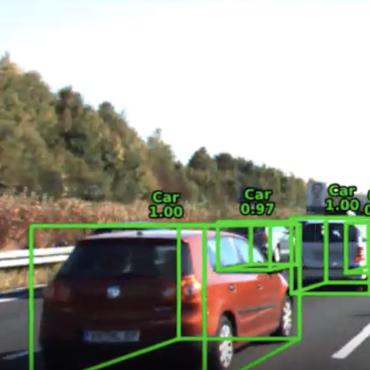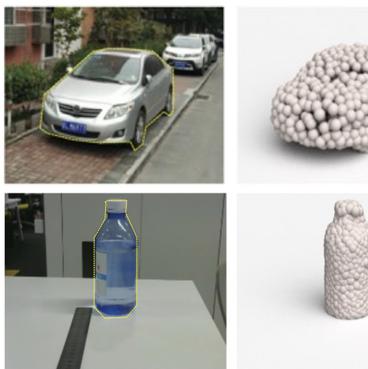Search Results for author: Yan Lu
Found 102 papers, 33 papers with code
A General Theory for Compositional Generalization
no code implementations • 20 May 2024 • Jingwen Fu, Zhizheng Zhang, Yan Lu, Nanning Zheng
Compositional Generalization (CG) embodies the ability to comprehend novel combinations of familiar concepts, representing a significant cognitive leap in human intellectual advancement.
Text Grouping Adapter: Adapting Pre-trained Text Detector for Layout Analysis
no code implementations • 13 May 2024 • Tianci Bi, Xiaoyi Zhang, Zhizheng Zhang, Wenxuan Xie, Cuiling Lan, Yan Lu, Nanning Zheng
Significant progress has been made in scene text detection models since the rise of deep learning, but scene text layout analysis, which aims to group detected text instances as paragraphs, has not kept pace.
Uncertainty-Aware Deep Video Compression with Ensembles
no code implementations • 28 Mar 2024 • Wufei Ma, Jiahao Li, Bin Li, Yan Lu
Deep learning-based video compression is a challenging task, and many previous state-of-the-art learning-based video codecs use optical flows to exploit the temporal correlation between successive frames and then compress the residual error.
RelationVLM: Making Large Vision-Language Models Understand Visual Relations
no code implementations • 19 Mar 2024 • Zhipeng Huang, Zhizheng Zhang, Zheng-Jun Zha, Yan Lu, Baining Guo
The development of Large Vision-Language Models (LVLMs) is striving to catch up with the success of Large Language Models (LLMs), yet it faces more challenges to be resolved.
Neural Video Compression with Feature Modulation
1 code implementation • 27 Feb 2024 • Jiahao Li, Bin Li, Yan Lu
This results in a better learning of the quantization scaler and helps our NVC support about 11. 4 dB PSNR range.
Slot-VLM: SlowFast Slots for Video-Language Modeling
no code implementations • 20 Feb 2024 • Jiaqi Xu, Cuiling Lan, Wenxuan Xie, Xuejin Chen, Yan Lu
A pivotal challenge is the development of an efficient method to encapsulate video content into a set of representative tokens to align with LLMs.
Diffusion Model with Cross Attention as an Inductive Bias for Disentanglement
no code implementations • 15 Feb 2024 • Tao Yang, Cuiling Lan, Yan Lu, Nanning Zheng
Disentangled representation learning strives to extract the intrinsic factors within observed data.
Retrieval-based Video Language Model for Efficient Long Video Question Answering
no code implementations • 8 Dec 2023 • Jiaqi Xu, Cuiling Lan, Wenxuan Xie, Xuejin Chen, Yan Lu
To address these issues, we introduce a simple yet effective retrieval-based video language model (R-VLM) for efficient and interpretable long video QA.
GUPNet++: Geometry Uncertainty Propagation Network for Monocular 3D Object Detection
1 code implementation • 24 Oct 2023 • Yan Lu, Xinzhu Ma, Lei Yang, Tianzhu Zhang, Yating Liu, Qi Chu, Tong He, Yonghui Li, Wanli Ouyang
It models the uncertainty propagation relationship of the geometry projection during training, improving the stability and efficiency of the end-to-end model learning.
Reinforced UI Instruction Grounding: Towards a Generic UI Task Automation API
no code implementations • 7 Oct 2023 • Zhizheng Zhang, Wenxuan Xie, Xiaoyi Zhang, Yan Lu
In this work, we build a multimodal model to ground natural language instructions in given UI screenshots as a generic UI task automation executor.
QDFormer: Towards Robust Audiovisual Segmentation in Complex Environments with Quantization-based Semantic Decomposition
3 code implementations • 29 Sep 2023 • Xiang Li, Jinglu Wang, Xiaohao Xu, Xiulian Peng, Rita Singh, Yan Lu, Bhiksha Raj
We propose a semantic decomposition method based on product quantization, where the multi-source semantics can be decomposed and represented by several disentangled and noise-suppressed single-source semantics.
Breaking through the learning plateaus of in-context learning in Transformer
no code implementations • 12 Sep 2023 • Jingwen Fu, Tao Yang, Yuwang Wang, Yan Lu, Nanning Zheng
To study the mechanism behind the learning plateaus, we conceptually seperate a component within the model's internal representation that is exclusively affected by the model's weights.
Transferability analysis of data-driven additive manufacturing knowledge: a case study between powder bed fusion and directed energy deposition
no code implementations • 12 Sep 2023 • Mutahar Safdar, Jiarui Xie, Hyunwoong Ko, Yan Lu, Guy Lamouche, Yaoyao Fiona Zhao
The framework consists of pre-transfer, transfer, and post-transfer steps to accomplish knowledge transfer.
Efficient View Synthesis with Neural Radiance Distribution Field
no code implementations • ICCV 2023 • Yushuang Wu, Xiao Li, Jinglu Wang, Xiaoguang Han, Shuguang Cui, Yan Lu
Specifically, we use a small network similar to NeRF while preserving the rendering speed with a single network forwarding per pixel as in NeLF.
StableVideo: Text-driven Consistency-aware Diffusion Video Editing
1 code implementation • ICCV 2023 • Wenhao Chai, Xun Guo, Gaoang Wang, Yan Lu
In this paper, we tackle this problem by introducing temporal dependency to existing text-driven diffusion models, which allows them to generate consistent appearance for the edited objects.
MovieChat: From Dense Token to Sparse Memory for Long Video Understanding
1 code implementation • 31 Jul 2023 • Enxin Song, Wenhao Chai, Guanhong Wang, Yucheng Zhang, Haoyang Zhou, Feiyang Wu, Haozhe Chi, Xun Guo, Tian Ye, Yanting Zhang, Yan Lu, Jenq-Neng Hwang, Gaoang Wang
Recently, integrating video foundation models and large language models to build a video understanding system can overcome the limitations of specific pre-defined vision tasks.
 Video-based Generative Performance Benchmarking (Consistency)
Video-based Generative Performance Benchmarking (Consistency)
 Video-based Generative Performance Benchmarking (Contextual Understanding)
+10
Video-based Generative Performance Benchmarking (Contextual Understanding)
+10
Adaptive Frequency Filters As Efficient Global Token Mixers
2 code implementations • ICCV 2023 • Zhipeng Huang, Zhizheng Zhang, Cuiling Lan, Zheng-Jun Zha, Yan Lu, Baining Guo
With this insight, we propose Adaptive Frequency Filtering (AFF) token mixer.
MotionGPT: Finetuned LLMs Are General-Purpose Motion Generators
no code implementations • 19 Jun 2023 • Yaqi Zhang, Di Huang, Bin Liu, Shixiang Tang, Yan Lu, Lu Chen, Lei Bai, Qi Chu, Nenghai Yu, Wanli Ouyang
Generating realistic human motion from given action descriptions has experienced significant advancements because of the emerging requirement of digital humans.
EVOPOSE: A Recursive Transformer For 3D Human Pose Estimation With Kinematic Structure Priors
no code implementations • 16 Jun 2023 • Yaqi Zhang, Yan Lu, Bin Liu, Zhiwei Zhao, Qi Chu, Nenghai Yu
Transformer is popular in recent 3D human pose estimation, which utilizes long-term modeling to lift 2D keypoints into the 3D space.
 Ranked #91 on
3D Human Pose Estimation
on Human3.6M
Ranked #91 on
3D Human Pose Estimation
on Human3.6M
Responsible Task Automation: Empowering Large Language Models as Responsible Task Automators
no code implementations • 2 Jun 2023 • Zhizheng Zhang, Xiaoyi Zhang, Wenxuan Xie, Yan Lu
In specific, we present Responsible Task Automation (ResponsibleTA) as a fundamental framework to facilitate responsible collaboration between LLM-based coordinators and executors for task automation with three empowered capabilities: 1) predicting the feasibility of the commands for executors; 2) verifying the completeness of executors; 3) enhancing the security (e. g., the protection of users' privacy).
Vector-based Representation is the Key: A Study on Disentanglement and Compositional Generalization
no code implementations • 29 May 2023 • Tao Yang, Yuwang Wang, Cuiling Lan, Yan Lu, Nanning Zheng
In this paper, we study several typical disentangled representation learning works in terms of both disentanglement and compositional generalization abilities, and we provide an important insight: vector-based representation (using a vector instead of a scalar to represent a concept) is the key to empower both good disentanglement and strong compositional generalization.
ReSup: Reliable Label Noise Suppression for Facial Expression Recognition
1 code implementation • 29 May 2023 • Xiang Zhang, Yan Lu, Huan Yan, Jingyang Huang, Yusheng Ji, Yu Gu
To further enhance the reliability of our noise decision results, ReSup uses two networks to jointly achieve noise suppression.
 Facial Expression Recognition
Facial Expression Recognition
 Facial Expression Recognition (FER)
Facial Expression Recognition (FER)
ABC-KD: Attention-Based-Compression Knowledge Distillation for Deep Learning-Based Noise Suppression
no code implementations • 26 May 2023 • Yixin Wan, Yuan Zhou, Xiulian Peng, Kai-Wei Chang, Yan Lu
To begin with, we are among the first to comprehensively investigate mainstream KD techniques on DNS models to resolve the two challenges.
Clothes-Invariant Feature Learning by Causal Intervention for Clothes-Changing Person Re-identification
no code implementations • 10 May 2023 • Xulin Li, Yan Lu, Bin Liu, Yuenan Hou, Yating Liu, Qi Chu, Wanli Ouyang, Nenghai Yu
Clothes-invariant feature extraction is critical to the clothes-changing person re-identification (CC-ReID).
High-Fidelity and Freely Controllable Talking Head Video Generation
no code implementations • CVPR 2023 • Yue Gao, Yuan Zhou, Jinglu Wang, Xiao Li, Xiang Ming, Yan Lu
Our method leverages both self-supervised learned landmarks and 3D face model-based landmarks to model the motion.
Mask-Based Modeling for Neural Radiance Fields
1 code implementation • 11 Apr 2023 • Ganlin Yang, Guoqiang Wei, Zhizheng Zhang, Yan Lu, Dong Liu
Most Neural Radiance Fields (NeRFs) exhibit limited generalization capabilities, which restrict their applicability in representing multiple scenes using a single model.
Two-shot Video Object Segmentation
1 code implementation • CVPR 2023 • Kun Yan, Xiao Li, Fangyun Wei, Jinglu Wang, Chenbin Zhang, Ping Wang, Yan Lu
The underlying idea is to generate pseudo labels for unlabeled frames during training and to optimize the model on the combination of labeled and pseudo-labeled data.
Structural Multiplane Image: Bridging Neural View Synthesis and 3D Reconstruction
no code implementations • CVPR 2023 • Mingfang Zhang, Jinglu Wang, Xiao Li, Yifei HUANG, Yoichi Sato, Yan Lu
The Multiplane Image (MPI), containing a set of fronto-parallel RGBA layers, is an effective and efficient representation for view synthesis from sparse inputs.
Unifying Layout Generation with a Decoupled Diffusion Model
no code implementations • CVPR 2023 • Mude Hui, Zhizheng Zhang, Xiaoyi Zhang, Wenxuan Xie, Yuwang Wang, Yan Lu
Since different attributes have their individual semantics and characteristics, we propose to decouple the diffusion processes for them to improve the diversity of training samples and learn the reverse process jointly to exploit global-scope contexts for facilitating generation.
Neural Video Compression with Diverse Contexts
2 code implementations • CVPR 2023 • Jiahao Li, Bin Li, Yan Lu
Better yet, our codec has surpassed the under-developing next generation traditional codec/ECM in both RGB and YUV420 colorspaces, in terms of PSNR.
Time-Variance Aware Real-Time Speech Enhancement
no code implementations • 25 Feb 2023 • Chengyu Zheng, Yuan Zhou, Xiulian Peng, Yuan Zhang, Yan Lu
Time-variant factors often occur in real-world full-duplex communication applications.
Real-time speech enhancement with dynamic attention span
no code implementations • 21 Feb 2023 • Chengyu Zheng, Yuan Zhou, Xiulian Peng, Yuan Zhang, Yan Lu
For real-time speech enhancement (SE) including noise suppression, dereverberation and acoustic echo cancellation, the time-variance of the audio signals becomes a severe challenge.
EVC: Towards Real-Time Neural Image Compression with Mask Decay
1 code implementation • 10 Feb 2023 • Guo-Hua Wang, Jiahao Li, Bin Li, Yan Lu
Both mask decay and residual representation learning greatly improve the RD performance of our scalable encoder.
Versatile Neural Processes for Learning Implicit Neural Representations
1 code implementation • 21 Jan 2023 • Zongyu Guo, Cuiling Lan, Zhizheng Zhang, Yan Lu, Zhibo Chen
In this paper, we propose an efficient NP framework dubbed Versatile Neural Processes (VNP), which largely increases the capability of approximating functions.
Motion Information Propagation for Neural Video Compression
no code implementations • CVPR 2023 • Linfeng Qi, Jiahao Li, Bin Li, Houqiang Li, Yan Lu
Meanwhile, besides assisting frame coding at the current time step, the feature from context generation will be propagated as motion condition when coding the subsequent motion latent.
VideoTrack: Learning To Track Objects via Video Transformer
no code implementations • CVPR 2023 • Fei Xie, Lei Chu, Jiahao Li, Yan Lu, Chao Ma
Existing Siamese tracking methods, which are built on pair-wise matching between two single frames, heavily rely on additional sophisticated mechanism to exploit temporal information among successive video frames, hindering them from high efficiency and industrial deployments.
Crossing the Gap: Domain Generalization for Image Captioning
no code implementations • CVPR 2023 • Yuchen Ren, Zhendong Mao, Shancheng Fang, Yan Lu, Tong He, Hao Du, Yongdong Zhang, Wanli Ouyang
In this paper, we introduce a new setting called Domain Generalization for Image Captioning (DGIC), where the data from the target domain is unseen in the learning process.
Robust Referring Video Object Segmentation with Cyclic Structural Consensus
no code implementations • ICCV 2023 • Xiang Li, Jinglu Wang, Xiaohao Xu, Xiao Li, Bhiksha Raj, Yan Lu
Our model achieves state-of-the-art performance on R-VOS benchmarks, Ref-DAVIS17 and Ref-Youtube-VOS, and also our RRYTVOS dataset.
Disentangled Feature Learning for Real-Time Neural Speech Coding
no code implementations • 22 Nov 2022 • Xue Jiang, Xiulian Peng, Yuan Zhang, Yan Lu
Recently end-to-end neural audio/speech coding has shown its great potential to outperform traditional signal analysis based audio codecs.
Estimating Neural Reflectance Field from Radiance Field using Tree Structures
no code implementations • 9 Oct 2022 • Xiu Li, Xiao Li, Yan Lu
A high-quality NeRF decomposition relies on good geometry information extraction as well as good prior terms to properly resolve ambiguities between different components.
Alignment-guided Temporal Attention for Video Action Recognition
no code implementations • 30 Sep 2022 • Yizhou Zhao, Zhenyang Li, Xun Guo, Yan Lu
Temporal modeling is crucial for various video learning tasks.
A Comprehensive Review of Digital Twin -- Part 2: Roles of Uncertainty Quantification and Optimization, a Battery Digital Twin, and Perspectives
no code implementations • 27 Aug 2022 • Adam Thelen, Xiaoge Zhang, Olga Fink, Yan Lu, Sayan Ghosh, Byeng D. Youn, Michael D. Todd, Sankaran Mahadevan, Chao Hu, Zhen Hu
This second paper presents a literature review of key enabling technologies of digital twins, with an emphasis on uncertainty quantification, optimization methods, open source datasets and tools, major findings, challenges, and future directions.
A Comprehensive Review of Digital Twin -- Part 1: Modeling and Twinning Enabling Technologies
no code implementations • 26 Aug 2022 • Adam Thelen, Xiaoge Zhang, Olga Fink, Yan Lu, Sayan Ghosh, Byeng D. Youn, Michael D. Todd, Sankaran Mahadevan, Chao Hu, Zhen Hu
In part two of this review, the role of uncertainty quantification and optimization are discussed, a battery digital twin is demonstrated, and more perspectives on the future of digital twin are shared.
Neural Capture of Animatable 3D Human from Monocular Video
no code implementations • 18 Aug 2022 • Gusi Te, Xiu Li, Xiao Li, Jinglu Wang, Wei Hu, Yan Lu
We present a novel paradigm of building an animatable 3D human representation from a monocular video input, such that it can be rendered in any unseen poses and views.
Counterfactual Intervention Feature Transfer for Visible-Infrared Person Re-identification
no code implementations • 1 Aug 2022 • Xulin Li, Yan Lu, Bin Liu, Yating Liu, Guojun Yin, Qi Chu, Jinyang Huang, Feng Zhu, Rui Zhao, Nenghai Yu
But we find existing graph-based methods in the visible-infrared person re-identification task (VI-ReID) suffer from bad generalization because of two issues: 1) train-test modality balance gap, which is a property of VI-ReID task.
Latent-Domain Predictive Neural Speech Coding
no code implementations • 18 Jul 2022 • Xue Jiang, Xiulian Peng, Huaying Xue, Yuan Zhang, Yan Lu
Neural audio/speech coding has recently demonstrated its capability to deliver high quality at much lower bitrates than traditional methods.
Neighbor Correspondence Matching for Flow-based Video Frame Synthesis
no code implementations • 14 Jul 2022 • Zhaoyang Jia, Yan Lu, Houqiang Li
Since the current frame is not available in video frame synthesis, NCM is performed in a current-frame-agnostic fashion to establish multi-scale correspondences in the spatial-temporal neighborhoods of each pixel.
 Ranked #2 on
Video Frame Interpolation
on X4K1000FPS
Ranked #2 on
Video Frame Interpolation
on X4K1000FPS
Hybrid Spatial-Temporal Entropy Modelling for Neural Video Compression
1 code implementation • 13 Jul 2022 • Jiahao Li, Bin Li, Yan Lu
Besides estimating the probability distribution, our entropy model also generates the quantization step at spatial-channel-wise.
Online Video Instance Segmentation via Robust Context Fusion
no code implementations • 12 Jul 2022 • Xiang Li, Jinglu Wang, Xiaohao Xu, Bhiksha Raj, Yan Lu
We propose a robust context fusion network to tackle VIS in an online fashion, which predicts instance segmentation frame-by-frame with a few preceding frames.
Cross-Scale Vector Quantization for Scalable Neural Speech Coding
no code implementations • 7 Jul 2022 • Xue Jiang, Xiulian Peng, Huaying Xue, Yuan Zhang, Yan Lu
In this paper, we introduce a cross-scale scalable vector quantization scheme (CSVQ), in which multi-scale features are encoded progressively with stepwise feature fusion and refinement.
Towards Robust Referring Video Object Segmentation with Cyclic Relational Consensus
1 code implementation • 4 Jul 2022 • Xiang Li, Jinglu Wang, Xiaohao Xu, Xiao Li, Bhiksha Raj, Yan Lu
Referring Video Object Segmentation (R-VOS) is a challenging task that aims to segment an object in a video based on a linguistic expression.
 Ranked #11 on
Referring Video Object Segmentation
on Refer-YouTube-VOS
Ranked #11 on
Referring Video Object Segmentation
on Refer-YouTube-VOS
 Referring Expression Segmentation
Referring Expression Segmentation
 Referring Video Object Segmentation
+2
Referring Video Object Segmentation
+2
Multi-Modal Multi-Correlation Learning for Audio-Visual Speech Separation
no code implementations • 4 Jul 2022 • Xiaoyu Wang, Xiangyu Kong, Xiulian Peng, Yan Lu
In this paper we propose a multi-modal multi-correlation learning framework targeting at the task of audio-visual speech separation.
Towards Robust Video Object Segmentation with Adaptive Object Calibration
1 code implementation • 2 Jul 2022 • Xiaohao Xu, Jinglu Wang, Xiang Ming, Yan Lu
We consolidate this conditional mask calibration process in a progressive manner, where the object representations and proto-masks evolve to be discriminative iteratively.
![]() Ranked #1 on
Visual Object Tracking
on YouTube-VOS
Ranked #1 on
Visual Object Tracking
on YouTube-VOS
Turbo: Opportunistic Enhancement for Edge Video Analytics
no code implementations • 29 Jun 2022 • Yan Lu, Shiqi Jiang, Ting Cao, Yuanchao Shu
Edge computing is being widely used for video analytics.
Visual Concepts Tokenization
2 code implementations • 20 May 2022 • Tao Yang, Yuwang Wang, Yan Lu, Nanning Zheng
We further propose a Concept Disentangling Loss to facilitate that different concept tokens represent independent visual concepts.
Test-time Batch Normalization
no code implementations • 20 May 2022 • Tao Yang, Shenglong Zhou, Yuwang Wang, Yan Lu, Nanning Zheng
Deep neural networks often suffer the data distribution shift between training and testing, and the batch statistics are observed to reflect the shift.
Self-Supervised Image Representation Learning with Geometric Set Consistency
no code implementations • CVPR 2022 • Nenglun Chen, Lei Chu, Hao Pan, Yan Lu, Wenping Wang
We propose a method for self-supervised image representation learning under the guidance of 3D geometric consistency.
Deep Frequency Filtering for Domain Generalization
no code implementations • CVPR 2023 • Shiqi Lin, Zhizheng Zhang, Zhipeng Huang, Yan Lu, Cuiling Lan, Peng Chu, Quanzeng You, Jiang Wang, Zicheng Liu, Amey Parulkar, Viraj Navkal, Zhibo Chen
Improving the generalization ability of Deep Neural Networks (DNNs) is critical for their practical uses, which has been a longstanding challenge.
Semantic-aligned Fusion Transformer for One-shot Object Detection
no code implementations • CVPR 2022 • Yizhou Zhao, Xun Guo, Yan Lu
One-shot object detection aims at detecting novel objects according to merely one given instance.
Neural Compression-Based Feature Learning for Video Restoration
no code implementations • CVPR 2022 • Cong Huang, Jiahao Li, Bin Li, Dong Liu, Yan Lu
The temporal features usually contain various noisy and uncorrelated information, and they may interfere with the restoration of the current frame.
Rethinking Minimal Sufficient Representation in Contrastive Learning
1 code implementation • CVPR 2022 • Haoqing Wang, Xun Guo, Zhi-Hong Deng, Yan Lu
It significantly improves the performance of several classic contrastive learning models in downstream tasks.
Active Token Mixer
2 code implementations • 11 Mar 2022 • Guoqiang Wei, Zhizheng Zhang, Cuiling Lan, Yan Lu, Zhibo Chen
In this work, we propose an innovative token-mixer, dubbed Active Token Mixer (ATM), to actively incorporate flexible contextual information distributed across different channels from other tokens into the given query token.
 Ranked #64 on
Object Detection
on COCO minival
Ranked #64 on
Object Detection
on COCO minival
Robust Nonparametric Distribution Forecast with Backtest-based Bootstrap and Adaptive Residual Selection
no code implementations • 16 Feb 2022 • Longshaokan Wang, Lingda Wang, Mina Georgieva, Paulo Machado, Abinaya Ulagappa, Safwan Ahmed, Yan Lu, Arjun Bakshi, Farhad Ghassemi
Distribution forecast can quantify forecast uncertainty and provide various forecast scenarios with their corresponding estimated probabilities.
Mask-based Latent Reconstruction for Reinforcement Learning
1 code implementation • 28 Jan 2022 • Tao Yu, Zhizheng Zhang, Cuiling Lan, Yan Lu, Zhibo Chen
For deep reinforcement learning (RL) from pixels, learning effective state representations is crucial for achieving high performance.
End-to-End Neural Speech Coding for Real-Time Communications
no code implementations • 24 Jan 2022 • Xue Jiang, Xiulian Peng, Chengyu Zheng, Huaying Xue, Yuan Zhang, Yan Lu
Deep-learning based methods have shown their advantages in audio coding over traditional ones but limited attention has been paid on real-time communications (RTC).
Recursive Least-Squares Estimator-Aided Online Learning for Visual Tracking
2 code implementations • CVPR 2020 • Jin Gao, Yan Lu, Xiaojuan Qi, Yutong Kou, Bing Li, Liang Li, Shan Yu, Weiming Hu
In this paper, we propose a simple yet effective recursive least-squares estimator-aided online learning approach for few-shot online adaptation without requiring offline training.
Continuous Human Action Detection Based on Wearable Inertial Data
no code implementations • 11 Dec 2021 • Xia Gong, Yan Lu, Haoran Wei
Human action detection is a hot topic, which is widely used in video surveillance, human machine interface, healthcare monitoring, gaming, dancing training and musical instrument teaching.
Reliable Propagation-Correction Modulation for Video Object Segmentation
1 code implementation • 6 Dec 2021 • Xiaohao Xu, Jinglu Wang, Xiao Li, Yan Lu
We introduce two modulators, propagation and correction modulators, to separately perform channel-wise re-calibration on the target frame embeddings according to local temporal correlations and reliable references respectively.
 Ranked #3 on
Video Object Segmentation
on DAVIS 2017 (test-dev)
Ranked #3 on
Video Object Segmentation
on DAVIS 2017 (test-dev)
Hybrid Instance-aware Temporal Fusion for Online Video Instance Segmentation
no code implementations • 3 Dec 2021 • Xiang Li, Jinglu Wang, Xiao Li, Yan Lu
Based on this representation, we introduce a cropping-free temporal fusion approach to model the temporal consistency between video frames.
Temporal Context Mining for Learned Video Compression
1 code implementation • 27 Nov 2021 • Xihua Sheng, Jiahao Li, Bin Li, Li Li, Dong Liu, Yan Lu
From the stored propagated features, we propose to learn multi-scale temporal contexts, and re-fill the learned temporal contexts into the modules of our compression scheme, including the contextual encoder-decoder, the frame generator, and the temporal context encoder.
Video Instance Segmentation by Instance Flow Assembly
no code implementations • 20 Oct 2021 • Xiang Li, Jinglu Wang, Xiao Li, Yan Lu
Instance segmentation is a challenging task aiming at classifying and segmenting all object instances of specific classes.
Deep Contextual Video Compression
1 code implementation • NeurIPS 2021 • Jiahao Li, Bin Li, Yan Lu
In this paper, we propose a deep contextual video compression framework to enable a paradigm shift from predictive coding to conditional coding.
Cross-Stage Transformer for Video Learning
no code implementations • 29 Sep 2021 • Yuanze Lin, Xun Guo, Yan Lu
By inserting the proposed cross-stage mechanism in existing spatial and temporal transformer blocks, we build a separable transformer network for video learning based on ViT structure, in which self-attentions and features are progressively aggregated from one block to the next.
What Makes for Good Representations for Contrastive Learning
no code implementations • 29 Sep 2021 • Haoqing Wang, Xun Guo, Zhi-Hong Deng, Yan Lu
Therefore, we assume the task-relevant information that is not shared between views can not be ignored and theoretically prove that the minimal sufficient representation in contrastive learning is not sufficient for the downstream tasks, which causes performance degradation.
Self-Supervised Video Representation Learning with Meta-Contrastive Network
no code implementations • ICCV 2021 • Yuanze Lin, Xun Guo, Yan Lu
Our method contains two training stages based on model-agnostic meta learning (MAML), each of which consists of a contrastive branch and a meta branch.
 Ranked #28 on
Self-Supervised Action Recognition
on HMDB51
Ranked #28 on
Self-Supervised Action Recognition
on HMDB51
Geometry Uncertainty Projection Network for Monocular 3D Object Detection
1 code implementation • ICCV 2021 • Yan Lu, Xinzhu Ma, Lei Yang, Tianzhu Zhang, Yating Liu, Qi Chu, Junjie Yan, Wanli Ouyang
In this paper, we propose a Geometry Uncertainty Projection Network (GUP Net) to tackle the error amplification problem at both inference and training stages.
 3D Object Detection From Monocular Images
3D Object Detection From Monocular Images
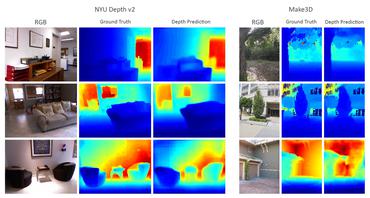 Depth Estimation
+3
Depth Estimation
+3
SSAN: Separable Self-Attention Network for Video Representation Learning
no code implementations • CVPR 2021 • Xudong Guo, Xun Guo, Yan Lu
However, spatial correlations and temporal correlations represent different contextual information of scenes and temporal reasoning.
MonoGRNet: A General Framework for Monocular 3D Object Detection
no code implementations • 18 Apr 2021 • Zengyi Qin, Jinglu Wang, Yan Lu
Detecting and localizing objects in the real 3D space, which plays a crucial role in scene understanding, is particularly challenging given only a monocular image due to the geometric information loss during imagery projection.
Phoneme-based Distribution Regularization for Speech Enhancement
no code implementations • 8 Apr 2021 • Yajing Liu, Xiulian Peng, Zhiwei Xiong, Yan Lu
Specifically, we propose a phoneme-based distribution regularization (PbDr) for speech enhancement, which incorporates frame-wise phoneme information into speech enhancement network in a conditional manner.
Custom Object Detection via Multi-Camera Self-Supervised Learning
no code implementations • 5 Feb 2021 • Yan Lu, Yuanchao Shu
This paper proposes MCSSL, a self-supervised learning approach for building custom object detection models in multi-camera networks.
T-Net: Effective Permutation-Equivariant Network for Two-View Correspondence Learning
1 code implementation • ICCV 2021 • Zhen Zhong, Guobao Xiao, Linxin Zheng, Yan Lu, Jiayi Ma
We develop a conceptually simple, flexible, and effective framework (named T-Net) for two-view correspondence learning.
Interactive Speech and Noise Modeling for Speech Enhancement
no code implementations • 17 Dec 2020 • Chengyu Zheng, Xiulian Peng, Yuan Zhang, Sriram Srinivasan, Yan Lu
In this paper, we propose a novel idea to model speech and noise simultaneously in a two-branch convolutional neural network, namely SN-Net.
 Ranked #1 on
Speech Enhancement
on Deep Noise Suppression (DNS) Challenge
(SI-SDR-NB metric)
Ranked #1 on
Speech Enhancement
on Deep Noise Suppression (DNS) Challenge
(SI-SDR-NB metric)
Weakly Supervised 3D Object Detection from Point Clouds
1 code implementation • 28 Jul 2020 • Zengyi Qin, Jinglu Wang, Yan Lu
A crucial task in scene understanding is 3D object detection, which aims to detect and localize the 3D bounding boxes of objects belonging to specific classes.
Weakly-supervised Temporal Action Localization by Uncertainty Modeling
2 code implementations • 12 Jun 2020 • Pilhyeon Lee, Jinglu Wang, Yan Lu, Hyeran Byun
Experimental results show that our uncertainty modeling is effective at alleviating the interference of background frames and brings a large performance gain without bells and whistles.
Scattering under Linear Non Self-Adjoint Operators: Case of in-Plane Elastic Waves
no code implementations • 6 Mar 2020 • Amir Ashkan Mokhtari, Yan Lu, Qiyuan Zhou, Alireza V. Amirkhizi, Ankit Srivastava
In this paper, we consider the problem of the scattering of in-plane waves at an interface between a homogeneous medium and a metamaterial.
Applied Physics
Cross-modality Person re-identification with Shared-Specific Feature Transfer
no code implementations • CVPR 2020 • Yan Lu, Yue Wu, Bin Liu, Tianzhu Zhang, Baopu Li, Qi Chu, Nenghai Yu
In this paper, we tackle the above limitation by proposing a novel cross-modality shared-specific feature transfer algorithm (termed cm-SSFT) to explore the potential of both the modality-shared information and the modality-specific characteristics to boost the re-identification performance.
 Cross-Modality Person Re-identification
Cross-Modality Person Re-identification
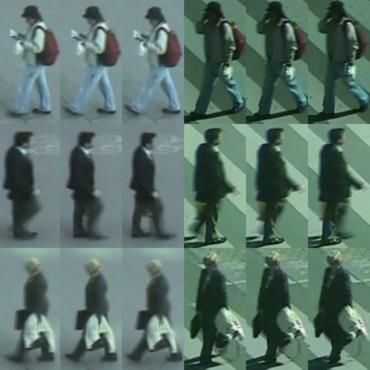 Person Re-Identification
Person Re-Identification
Reinforcement learning for bandwidth estimation and congestion control in real-time communications
no code implementations • 4 Dec 2019 • Joyce Fang, Martin Ellis, Bin Li, Siyao Liu, Yasaman Hosseinkashi, Michael Revow, Albert Sadovnikov, Ziyuan Liu, Peng Cheng, Sachin Ashok, David Zhao, Ross Cutler, Yan Lu, Johannes Gehrke
Bandwidth estimation and congestion control for real-time communications (i. e., audio and video conferencing) remains a difficult problem, despite many years of research.
Triangulation Learning Network: from Monocular to Stereo 3D Object Detection
1 code implementation • CVPR 2019 • Zengyi Qin, Jinglu Wang, Yan Lu
In this paper, we study the problem of 3D object detection from stereo images, in which the key challenge is how to effectively utilize stereo information.
Relational Knowledge Distillation
3 code implementations • CVPR 2019 • Wonpyo Park, Dongju Kim, Yan Lu, Minsu Cho
Knowledge distillation aims at transferring knowledge acquired in one model (a teacher) to another model (a student) that is typically smaller.
See Better Before Looking Closer: Weakly Supervised Data Augmentation Network for Fine-Grained Visual Classification
4 code implementations • 26 Jan 2019 • Tao Hu, Honggang Qi, Qingming Huang, Yan Lu
Specifically, for each training image, we first generate attention maps to represent the object's discriminative parts by weakly supervised learning.
 Ranked #12 on
Fine-Grained Image Classification
on CUB-200-2011
Ranked #12 on
Fine-Grained Image Classification
on CUB-200-2011
Real-Time Anomaly Detection With HMOF Feature
no code implementations • 12 Dec 2018 • Huihui Zhu, Bin Liu, Guojun Yin, Yan Lu, Weihai Li, Nenghai Yu
Most existing methods are computation consuming, which cannot satisfy the real-time requirement.
Affinity Derivation and Graph Merge for Instance Segmentation
1 code implementation • ECCV 2018 • Yiding Liu, Siyu Yang, Bin Li, Wengang Zhou, Jizheng Xu, Houqiang Li, Yan Lu
We present an instance segmentation scheme based on pixel affinity information, which is the relationship of two pixels belonging to a same instance.
MonoGRNet: A Geometric Reasoning Network for Monocular 3D Object Localization
1 code implementation • 26 Nov 2018 • Zengyi Qin, Jinglu Wang, Yan Lu
We propose MonoGRNet for the amodal 3D object detection from a monocular RGB image via geometric reasoning in both the observed 2D projection and the unobserved depth dimension.
 Ranked #26 on
Monocular 3D Object Detection
on KITTI Cars Moderate
Ranked #26 on
Monocular 3D Object Detection
on KITTI Cars Moderate
MVPNet: Multi-View Point Regression Networks for 3D Object Reconstruction from A Single Image
no code implementations • 23 Nov 2018 • Jinglu Wang, Bo Sun, Yan Lu
In this paper, we address the problem of reconstructing an object's surface from a single image using generative networks.
In Defense of the Classification Loss for Person Re-Identification
1 code implementation • 16 Sep 2018 • Yao Zhai, Xun Guo, Yan Lu, Houqiang Li
The recent research for person re-identification has been focused on two trends.
Weakly Supervised Bilinear Attention Network for Fine-Grained Visual Classification
no code implementations • 6 Aug 2018 • Tao Hu, Jizheng Xu, Cong Huang, Honggang Qi, Qingming Huang, Yan Lu
Besides, we propose attention regularization and attention dropout to weakly supervise the generating process of attention maps.
Local Descriptors Optimized for Average Precision
no code implementations • CVPR 2018 • Kun He, Yan Lu, Stan Sclaroff
In this paper, we improve the learning of local feature descriptors by optimizing the performance of descriptor matching, which is a common stage that follows descriptor extraction in local feature based pipelines, and can be formulated as nearest neighbor retrieval.
Feature Selective Networks for Object Detection
no code implementations • CVPR 2018 • Yao Zhai, Jingjing Fu, Yan Lu, Houqiang Li
The RoI-based sub-region attention map and aspect ratio attention map are selectively pooled from the banks, and then used to refine the original RoI features for RoI classification.
Robust RGB-D Odometry Using Point and Line Features
no code implementations • ICCV 2015 • Yan Lu, Dezhen Song
To meet the challenges, we fuse point and line features to form a robust odometry algorithm.
Content adaptive screen image scaling
no code implementations • 21 Oct 2015 • Yao Zhai, Qifei Wang, Yan Lu, Shipeng Li
This paper proposes an efficient content adaptive screen image scaling scheme for the real-time screen applications like remote desktop and screen sharing.
Human Activity Recognition using Smartphone
no code implementations • 30 Jan 2014 • Amin Rasekh, Chien-An Chen, Yan Lu
In this project, we design a robust activity recognition system based on a smartphone.










